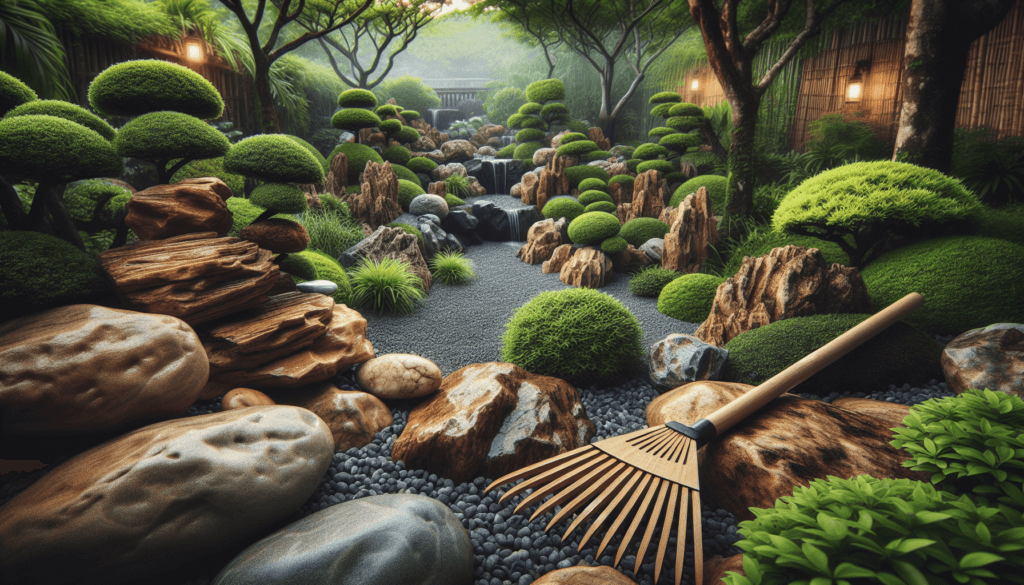Imagine transforming your yard into a tranquil oasis of natural beauty with your very own rock garden. This DIY guide will show you step-by-step how to create the perfect rock garden in your own yard, allowing you to surround yourself with the soothing sounds of nature and the breathtaking sight of carefully arranged rocks and plants. Whether you have a green thumb or are new to gardening, this guide will provide you with all the tips and tricks you need to create a stunning rock garden that will be the envy of your neighbors. So grab your gardening gloves and get ready to embark on a rewarding and creative journey as you transform your yard into a haven of serenity.

Choosing the Perfect Location
When creating a rock garden in your yard, the first step is to carefully choose the perfect location for it. Assessing sunlight and shade is crucial as most rock garden plants thrive in full sunlight. Look for an area in your yard that receives at least six hours of direct sunlight per day. This will ensure that your plants receive the optimal amount of light they need to flourish.
In addition to sunlight, considering drainage is essential. Rock gardens are designed to mimic the natural environment, so it’s important to choose a location where water drains well. Avoid areas that are prone to standing water or have poor drainage. This can be detrimental to the health of your plants and lead to root rot. Ensuring good drainage will help your rock garden thrive and prevent any water-related issues.
Lastly, determining accessibility is an important factor to consider when choosing the location for your rock garden. You want to pick a spot that is easily accessible for maintenance and enjoyment. Make sure it’s within reach of a watering source, and consider how easy it will be to weed and prune the plants. Choosing a location that is easily accessible will make the maintenance of your rock garden much more enjoyable in the long run.
Preparing the Site
Once you have chosen the perfect location for your rock garden, it’s time to prepare the site. Start by clearing the area of any vegetation, such as grass and weeds. This can be done by manually removing them or using a herbicide specifically designed for grass and weed elimination. Clearing the area will provide a clean slate for your rock garden and prevent any unwanted plants from competing with your chosen plants.
After clearing the area, it’s important to level the ground. This can be done by using a shovel and a rake to remove any bumps or depressions. Leveling the ground will not only make your rock garden visually appealing but also ensure proper drainage and prevent any water pooling in the future.
Another crucial step in preparing the site is adding drainage material. This can be done by layering the bottom of your rock garden with gravel or crushed stone. This will help facilitate proper drainage, prevent water buildup, and ensure the longevity of your rock garden. Be sure to evenly spread the drainage material throughout the entire area to promote uniform drainage.

Designing Your Rock Garden
Designing your rock garden is an exciting stage where you can unleash your creativity. Before getting started, it’s important to research different rock garden styles to find the one that best suits your taste and the overall aesthetic of your yard. Whether you prefer a Japanese-inspired rock garden or a more rustic and natural look, gathering inspiration and ideas will help you create a cohesive design.
Once you have a clear vision of your desired rock garden style, it’s time to create a layout. Consider the size and shape of your yard, as well as any existing features or structures. Sketch out a rough diagram of how you envision the placement of rocks, plants, and other elements within your rock garden. This will serve as a roadmap during the installation process and ensure that the final result meets your expectations.
Choosing rocks and boulders is a crucial step in designing your rock garden. Select rocks that match the style of your rock garden and vary in size and shape to create visual interest. Consider the color and texture of the rocks as well, as they play a significant role in the overall aesthetic of your garden. Visit local nurseries or landscaping stores to handpick the rocks that speak to you and complement your design.
In addition to rocks, selecting suitable plants for your rock garden is of utmost importance. Choose plants that are compatible with the amount of sunlight your chosen location receives and complement the style of your rock garden. Look for plants that thrive in well-drained soil and can withstand the sometimes harsh conditions of a rock garden. Incorporate a variety of colors, textures, and heights to create a visually appealing and diverse garden.
Installing Rocks and Boulders
Installing rocks and boulders is a crucial step in bringing your rock garden design to life. Start by placing larger rocks in strategic locations throughout your garden. These rocks will serve as focal points and anchor the overall design. Take your time to find the perfect placement for each rock, considering factors such as shape, size, and overall visual impact.
Creating naturalistic groupings is essential to achieve a realistic and pleasing look in your rock garden. Arrange smaller rocks around larger ones in a way that mimics how rocks would naturally occur in the environment. Pay attention to the angles and orientation of each rock, as these details can greatly enhance the naturalistic feel of your garden. Remember to leave spaces between the rocks for planting and visual interest.
Stacking rocks can add a unique and creative touch to your rock garden. By carefully balancing and stacking rocks of various sizes, you can create visually striking features and add dimension to your garden. Stacked rocks can be used to define pathways, create cascading water effects, or even form miniature rock walls. Experiment with different stacking techniques to find the arrangement that best suits your taste and design.

Preparing the Soil
Properly preparing the soil is key to ensuring the success of your rock garden. Start by testing the soil quality to determine its pH level and nutrient content. This will help you understand if any amendments are needed to optimize the growing conditions for your chosen plants. Soil testing kits are readily available at garden centers and will provide you with valuable information to make informed decisions.
Amending the soil may be necessary to adjust its pH level or improve its nutrient content. This can be done by adding organic matter, such as compost or well-rotted manure, to the soil. Organic matter will enhance soil structure, increase water retention, and supply essential nutrients to your plants. Incorporate the amendments thoroughly into the soil to ensure even distribution and optimal growing conditions.
Adding organic matter is particularly important in a rock garden, as it helps improve drainage. By enhancing the soil’s ability to drain excess water, you will prevent waterlogging and promote healthy root growth. Be mindful of the type and amount of organic matter you add, as some plants may have specific soil preferences. Research the individual needs of your chosen plants and adjust the soil amendments accordingly.
Improving drainage in a rock garden goes beyond amending the soil. Consider incorporating drainage features such as perforated pipes or French drains if your chosen location has poor natural drainage. These additions can help redirect excess water away from your rock garden and prevent water-related issues. Consult with a professional if you need assistance in designing and implementing a drainage system.
Planting the Garden
Choosing suitable plants is essential when it comes to planting your rock garden. Consider the specific growing requirements of each plant, including sunlight, soil type, and moisture needs. Select plants that are well-suited for the conditions of your rock garden, ensuring they can thrive in well-drained soil and withstand the sometimes harsh microclimate created by rocks and boulders.
When arranging the plants in your rock garden, consider their height and color. Place taller plants towards the back of the garden to create depth and a sense of perspective. Use medium-height plants to fill the mid-ground, and low-growing plants or ground covers for the front. This layering technique will ensure that each plant is showcased while creating a visually appealing and balanced composition.
Spacing plants appropriately is crucial for their overall health and aesthetic appeal. Consider the mature size of each plant and provide enough space for them to grow without overcrowding. Proper spacing will prevent plants from competing for resources and optimize air circulation, reducing the risk of fungal diseases. Follow the recommended spacing guidelines for each plant or consult with a horticultural expert for personalized advice.
Seasonal interest should also be taken into account when selecting plants for your rock garden. Choose plants that offer color, texture, or blooms throughout different seasons to ensure year-round visual appeal. Incorporate evergreen plants for winter interest and select early spring or late autumn bloomers to add bursts of color during transitional periods. With careful plant selection, you can enjoy the beauty of your rock garden all year long.

Mulching and Watering
Mulching your rock garden provides several benefits that contribute to the overall health and maintenance of the garden. Apply a layer of mulch to conserve moisture in the soil, reduce weed growth, and regulate soil temperature. Organic mulches, such as wood chips or bark, are excellent choices for a rock garden as they blend harmoniously with the natural environment.
Using gravel or pebbles as mulch can also be an attractive and practical option for a rock garden. These materials not only conserve moisture but also help improve drainage and prevent erosion. Choose gravel or pebbles that complement the color and texture of your rocks to create a cohesive and visually pleasing aesthetic. Spread the gravel or pebbles evenly, ensuring that the entire surface is covered.
Watering techniques for rock gardens may vary depending on the specific needs of your plants and the climatic conditions in your area. Generally, it’s recommended to water deeply and infrequently, allowing the soil to dry out slightly between waterings. This promotes deep root growth and prevents waterlogging, which can be detrimental to the health of your plants. Adjust the frequency and duration of watering based on the weather and the individual requirements of your plants.
Considering irrigation systems can simplify the watering process and help maintain optimal moisture levels in your rock garden. Drip irrigation or soaker hoses are excellent options for rock gardens as they deliver water directly to the roots, minimizing evaporation and water waste. Automating the watering process will also provide peace of mind during vacations or dry spells when manual watering may not be feasible.
Maintaining Your Rock Garden
Regular maintenance is essential to keep your rock garden looking its best. Regularly weed the garden to remove any unwanted vegetation that may compete with your chosen plants. This will also prevent the weeds from spreading their seeds and creating a bigger issue in the long run. Weed the rock garden by hand or use a hoe or weed puller to make the task easier and more efficient.
Pruning and trimming plants will help maintain their shape, promote healthy growth, and prevent overcrowding. Remove any dead or diseased foliage promptly to prevent the spread of pests or diseases. Prune as needed to maintain the desired size and shape of each plant, ensuring they have enough space for optimal growth. Use clean and sharp pruning tools to make clean cuts and minimize the risk of infection.
Feeding and fertilizing your rock garden plants will provide them with the necessary nutrients to thrive. Use a balanced, slow-release fertilizer specifically formulated for rock garden plants. Follow the package instructions for proper application rates and timings. Regularly feeding your plants will encourage vigorous growth, enhance their bloom potential, and boost overall plant health.
Controlling pests and diseases is an important aspect of rock garden maintenance. Regularly inspect your plants for any signs of pest infestation or disease symptoms. Act promptly to identify the culprit and implement appropriate control measures. This can range from handpicking pests to applying organic or chemical treatments, depending on the severity of the issue. Regular monitoring and early intervention will help keep your rock garden healthy and pest-free.

Adding Extras
Incorporating pathways or stepping stones can add functionality and visual appeal to your rock garden. Consider creating meandering paths that lead visitors through the garden, providing different viewpoints and perspectives. Use natural materials such as flagstones or gravel for a harmonious and organic look. Stepping stones can also serve as focal points or define specific areas within the garden.
Installing decorative features can enhance the overall ambiance of your rock garden. Consider adding elements such as small water features, bird baths, or garden sculptures to create points of interest and attract wildlife. Choose features that complement the style and theme of your rock garden, and place them strategically to create visually appealing compositions. Adding decorative features will make your rock garden feel more personalized and inviting.
Outdoor lighting can illuminate your rock garden and create a magical atmosphere during the evening hours. Install low-voltage lighting fixtures strategically to highlight the focal points and key elements of your garden. Use warm-toned bulbs to create a cozy and inviting ambiance. Outdoor lighting will extend the enjoyment of your rock garden into the nighttime and allow you to appreciate its beauty at any hour.
Including seating areas in your rock garden will provide a space for relaxation and contemplation. Choose comfortable and weather-resistant furniture that complements the style of your rock garden. Consider placing seating areas strategically to take advantage of different viewpoints or provide secluded spots for tranquility. Adding seating areas will encourage you and your guests to fully immerse in the beauty and serenity of your rock garden.
Inspiration and Tips
Utilizing vertical space in your rock garden can greatly enhance its visual appeal. Incorporate tall, slender plants or climbing vines to add height and vertical interest. Consider placing trellises or arbors to provide support for vertical growth. By making use of the vertical dimension, you can create a more dynamic and visually striking rock garden.
Creating rock terraces can add dimension and depth to your landscape. If your yard has a slope or uneven terrain, consider building rock walls or terraces to create different levels within your rock garden. This not only adds visual interest but also creates microclimates for planting a wider range of plants. Ensure proper drainage between terraces to prevent waterlogging and erosion.
Blending rocks and water features can create a captivating and serene atmosphere in your rock garden. Consider incorporating a small pond, a bubbling waterfall, or a trickling stream into your design. Strategically place rocks in and around the water feature to create a natural look. The combination of rocks and water will not only provide a soothing sound but also attract wildlife, such as birds and butterflies.
Considering native plants when choosing plants for your rock garden can have numerous benefits. Native plants are adapted to the local climate and soil conditions, making them more resilient and low-maintenance. They also provide food and habitat for local wildlife, contributing to the overall ecological balance. Research the native plant species in your area and incorporate them into your rock garden for a sustainable and environmentally friendly approach.
Creating a rock garden in your yard is an exciting and fulfilling DIY project. By carefully choosing the perfect location, preparing the site, designing the garden, installing rocks, and taking care of the plants, you can create a stunning and low-maintenance landscape feature. Follow these steps, draw inspiration from different styles, and incorporate your personal touches to create a rock garden that reflects your unique taste and brings joy for years to come.


